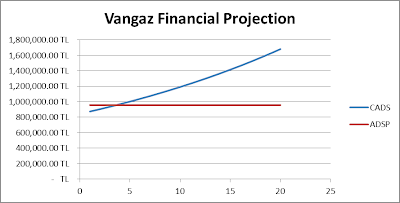Turkey has started to meet its electricity need from Natural
Gas starting from 1985 at a growing rate, and as of 2011 installed capacity
ratio of Natural Gas fired plants to total is 48.47%, while ratio of
electricity supplied from these plants to total amounts to 45.36%. With these
high ratios, analyzing energy intensity rate of these power plants would make
sense in order to get a sip of sustainable development projections in Turkey.
With regard to these graphs, important data that we will
focus on later is as follows;
Year
|
∆ Installed Capacity
|
∆ Production
|
2005
|
7.66%
|
7.47%
|
2006
|
6.46%
|
8.86%
|
2007
|
-0.87%
|
8.65%
|
2008
|
-4.86%
|
3.58%
|
2009
|
6.49%
|
-1.82%
|
2010
|
11.37%
|
8.42%
|
2011
|
0.62%
|
8.61%
|
At this point, focusing on energy intensities of these power
plants on resource base, which is natural gas, will let us contemplate how
efficiently these plants are functioning. When we analyze natural gas use in
cubic meters in electricity sector with regard to total electricity produced in
GWh from natural gas, resource based energy intensity ratio will look as in the
following graph;
Data Source: Energy Balance Tables, ETKB (Ministry of Energy and Natural Resources), www.enerji.gov.tr
By using average energy intensity ratio, one can easily
calculate how much natural gas will be used by one power plant on average as
long as projected production is given for that plan in a year. Yet, while such
an intensity ratio makes sense investment and financial wise for a corporation,
tying this resource based energy intensity to Economic agenda is the crucial
one. That is to say, when we can adapt such an intensity measure to GDP
development and further to GDP per capita in Turkey, we will be able to
recommend policies in energy sector to maintain sustainable development. In
that sense, what we do here is to compare these figures with economic data,
mainly GDP per capita with current USD. The following graph shows the
relationship between the two:
What is striking here is that the correlation of resource
based energy intensity with regard to GDP (Current USD) per Capita goes on a
line from 2005 to 2011, except years 2009 and 2010! What makes these two
outlier years is that there had been economic contraction in 2009 with a ratio
of -4.83%. That is why, contemplating -4.83% GDP decrease for the former one
and 9.16% increase for the latter one, crisis year 2009 and post-crisis year
2010 have been outliers. Once we eliminate these crisis-related years from the
analysis, the picture becomes obvious; as the welfare increases for the
citizens in terms of GDP per Capita, energy intensity for Natural Gas fired
plants increase on a straight line. That should attract those who deal with
economic agenda since more of natural resource will be consumed to maintain
sustainable development.
Now it is time to conclude these data analyses and bring up
some policy recommendations:
- During a crisis year, energy intensity of NG fired plants increases, which means efficiency of the plants is lowered. In that sense, although crisis cannot be eliminated and thus inefficiency for plants, one can at least closely monitor post-crisis period when there can happen a boom in order to curb energy intensity for some efficiency gains.
- When we look at the data that show the change in both Installed capacity and Electricity produced, this is the conclusion;
o
When ∆ Production < ∆ Installed Capacity,
energy intensity increases and thus efficiency decreases – 2009 & 2010
cases
o
When ∆ Installed Capacity < ∆ Production,
energy intensity decreases and thus efficiency increases – 2005, 2006, 2007,
2008 & 2011 cases
Simply said:
Therefore, authorities should make sure that electricity production by NG fired plants is tied to investment in capacity so as to gain efficiency.
∆
P > ∆ IC
|
∆
P < ∆ IC
|
|
Energy
Intensity
|
↓
|
↑
|
Therefore, authorities should make sure that electricity production by NG fired plants is tied to investment in capacity so as to gain efficiency.
- In order to maintain sustainable development, innovation and efficiency for these power plants are of utmost importance in such a country with resource constraints as Turkey, which is energy dependent one. Therefore, policy tools to encourage efficiency in these plants as economic development takes place will curb energy intensity and thus current deficit, and will pave the way for economic welfare without monetary stress for these resources. To further understand this issue, the following illustration will better explain it graphically:
After year 2011, we assume that 16,000
USD/Capita welfare standard will be achieved in another 6-7 years. In business
as usual scenario, correlation of energy intensity and GDP/capita will walk on
the straight line and more energy will be needed to achieve higher standard of
welfare. At the end, on welfare point 16,000 USD/Capita, around 0.000226
Billion m3 of Natural Gas should be consumed to produce 1 GWh of Energy under
base scenario. However, when incentive programs are applied in two successive
periods to improve efficiency, around 0.000223 Billion m3 of Natural Gas should
be consumed to produce 1 GWh of Energy. Thus, less of total energy will be
consumed in successive years.










